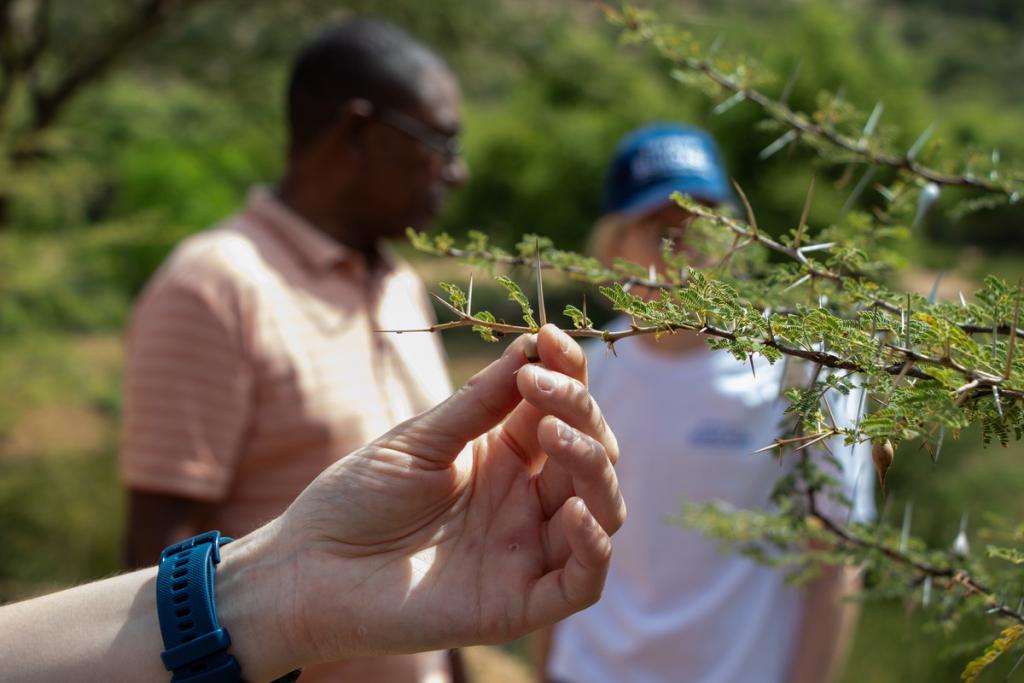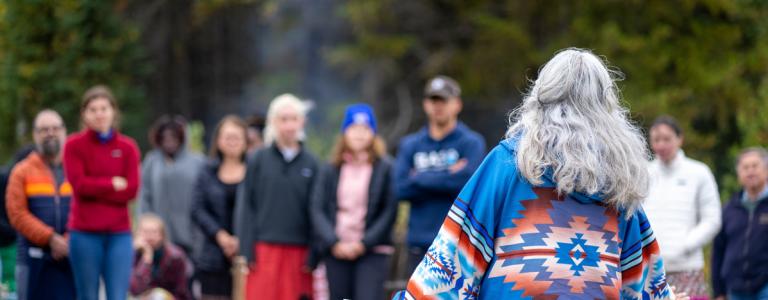For Nature-Based Solutions to Be Effective, We Need to Work with Indigenous Peoples and Local Communities
Nature-based solutions have been praised as a promising approach to tackling the twin crises of climate change and biodiversity loss. But some Indigenous Peoples and local communities are questioning the legitimacy of the concept and what it symbolizes. It is time to listen to what they have to say.
Nature-based solutions (NbS) have the potential to address multiple societal challenges while providing benefits for human well-being and biodiversity. But some Indigenous Peoples and local communities are raising concerns about the risks of parachute science, the commodification of nature, a lack of recognition of nature’s intrinsic value, and the fairness of benefit distribution from NbS projects. They are therefore calling upon Global North governments, organizations, and practitioners to adopt more inclusive and respectful engagement strategies in NbS projects that properly value their unique knowledge, traditions, and contributions.
Indigenous Peoples: Local environmental stewards
While NbS are still a relatively new concept, measures to protect, conserve, restore, sustainably use, and manage ecosystems to benefit human well-being and biodiversity are not. Indigenous Peoples have practiced environmental stewardship for millennia, guided by knowledge that is deeply rooted in the local context and has been passed down through generations. Today, they protect 80% of all biodiversity on the planet within their traditional territories.
Along the northeastern coastline of Quadra Island, British Columbia, clam gardens dating back 3,500 years provide an abundance of food for not only humans but also coastal wildlife. Built by the coastal First Nations, the clam gardens have been and continue to be sustainably managed through traditional management practices and harvest restrictions.
Indigenous Peoples have practiced environmental stewardship for millennia. Today, they protect 80% of all biodiversity on the planet within their traditional territories.
Further north lies the expansive and pristine wilderness of the Kaska Dena Ancestral Territory. The Kaska Dena are First Nations people whose land spans across British Columbia, Yukon, and the Northwest Territories. The British Columbia portion is stewarded through an Indigenous Guardians program called the Dane Nan Yḗ Dāh Network, which means “people taking care of the land.” The Guardians use Traditional Knowledge and community input to guide the sustainable management of their land and wildlife and monitor climate change.
It is important to note that while some local communities are Indigenous, not all are. Regardless of indigeneity, it is crucial to recognize the valuable insights and deep understanding these communities have of their local context. Their lived experiences and connection to the Earth are essential in shaping effective NbS projects.

An important distinction between Indigenous Peoples and local communitiesIndigenous Peoples are groups of people that have lived in a specific area since long before colonization. For this reason, they have strong ties with their lands and share unique knowledge, culture, and traditions that have been passed down through generations for hundreds of years. Local communities are small populations that live together in a specific and often rural area. They can consist of people with a diverse range of backgrounds who often have lifestyles tied to natural resources. While local communities can be Indigenous or have Indigenous Peoples as members, it is important to distinguish the two. |
Building Bridges Between Western Science and Traditional and Local Knowledge
Given the international nature of many NbS projects, practitioners with Western views and ideologies often work in countries outside of their own. This context can create power imbalances and requires practitioners to learn from communities about local contexts. A crucial first step is acknowledging that Western science is just one of many valuable knowledge systems. Traditional and local knowledge tend to be overlooked but can be complementary to Western science. So, how can NbS practitioners work with Indigenous Peoples and local communities to enhance their projects without being extractive and reinforcing Western dominance?
The answer lies within the question itself: working together. Indigenous Peoples and local communities worldwide have repeatedly expressed their desire to be included in NbS projects, given their years of experience and unparalleled expertise in environmental management.
Communities are upset and tired of being the front page of the magazine or a part of the video; they want to be part of the solution.
Making space for co-creation and finding ways to weave different knowledge systems together can result in more effective, sustainable, and inclusive NbS projects that truly address the needs and priorities of the communities they aim to serve.
While this is no easy endeavour, encouraging examples have emerged from academia and practice. For instance, Kate Raworth, author of Doughnut Economics, is collaborating with Native Hawaiian Professor Kamanamaikalani Beamer on a new conceptualization of her economic approach that centres entire ecosystems rather than just humans. This aligns with the beliefs of many Indigenous Peoples and local communities that humans are part of nature rather than a separate entity.
In Zanzibar, a climate resilience planning toolkit was designed with local cooperatives by combining the technical expertise of the International Institute for Environment and Development on intersectional approaches with community expertise on climate risks and adaptation strategies. The co-creation of this toolkit addressed shortcomings from previous climate adaptation investments in the communities that overlooked gender inequalities and the inclusion of youth. The collaboration has since fostered more intersectional adaptation planning within the cooperatives, demonstrating that combining diverse forms of knowledge can lead to more effective, inclusive, and sustainable projects.
When it comes to working together with Indigenous Knowledge and Western science, IISD Experimental Lakes Area (IISD-ELA) has been building relationships and collaborating in areas of common interest for nearly a decade—including research projects, cultural events, and the inclusion of Indigenous Knowledge in educational programming. The Manoomin (wild rice) project partners freshwater science with traditional ways of knowing to bring wild rice back to Indigenous communities in a way that will strengthen Indigenous economies, help the environment, see communities reclaim powers over their food systems, and have a lasting impact on the cultural preservation of wild rice. IISD-ELA explores how Western and Indigenous approaches to science can, and should, be working in tandem to further understanding and protection of fresh water and the environment overall.

Practitioners must adopt approaches that respect and incorporate the priorities, cultures, values, and knowledge of Indigenous Peoples and local communities.
Growing Positive Change
While NbS remain contentious, if done right, they have the potential to address climate change, biodiversity loss, and other societal challenges. This means adopting approaches that respect and incorporate the priorities, cultures, values, and knowledge of Indigenous Peoples and local communities.
Practitioners must act on calls from Indigenous Peoples and local communities to adopt more inclusive and respectful engagement strategies that allow for learning and community input from the outset of a project. A few ways to start are to build trust and relationships with Indigenous Peoples and local communities from the outset of projects, be open to learning about and understanding different types of knowledge, establish grievance mechanisms, adapt projects to communities’ needs and priorities (including being open to shifting the direction of project activities), and ensure that there is enough time and money available to do so.
You might also be interested in
Advancing Gender-Responsive and Socially Inclusive Practices in Nature-Based Solutions for Adaptation
Get inspired by two nature-based solutions for climate adaptation projects that integrate gender equality and social inclusion considerations at various stages of implementation.
How Can We Work With Nature to Tackle Drought and Desertification?
Drought is one of the most devastating and pervasive challenges exacerbated by climate change. However, we can work to reduce its effects through nature-based solutions for land restoration and climate-smart agriculture.
Challenging Gender Discriminatory Norms, Practices, and Beliefs in Sub-Saharan Africa
SUNCASA held a series of training sessions to support women and other underrepresented groups in overcoming the barriers preventing their access to natural resources and meaningful participation in nature-based solutions governance.
Mainstreaming Gender Equality and Social Inclusion in Nature-Based Solutions for Climate Change Adaptation
Discover tools, recommendations, and case studies on how to plan, design, and implement nature-based solutions for adaptation that advance gender equality and social inclusion while enhancing resilience, biodiversity, and ecosystem integrity.
